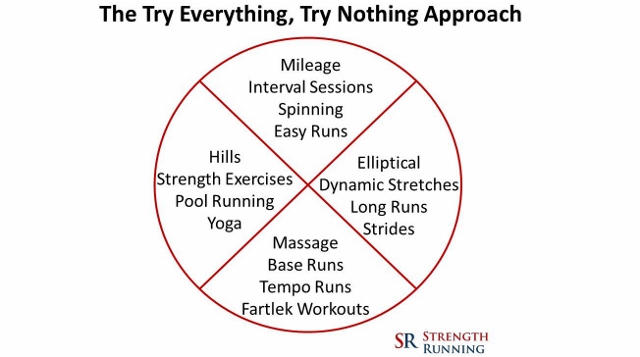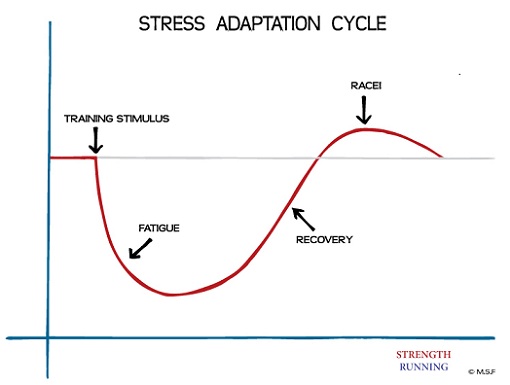Have you ever noticed that some runners know exactly what to do, but others seem constantly lost?
Every runner faces overwhelming information overload when it comes to planning their training or treating an injury. There’s an endless amount of advice out there.
Some coaching guidance is just terrible. But there are pillars of light in the dark, providing sound advice when you need it.
Unfortunately, it can be really difficult to know what to do. So many runners do nothing – they fall prey to paralysis by analysis. And they’re stuck in a vicious cycle of dealing with constant little injuries, not knowing whether to run, lift, or rest, or being terrified of increasing their mileage.
Even worse, some runners tackle an injury or their training with a haphazard and uncoordinated plan that’s like the shotgun approach – try as much as possible and see what sticks.
There’s no progression. There’s no consistency. There’s no system.
Introducing the Try Everything, Try Nothing Approach
Every runner WANTS to reach their goals, but obviously “figuring it out” doesn’t work if you have no plan. Too many runners resort to the Try Everything, Try Nothing Approach – and fail.
This approach describes the shotgun approach to training or injury treatment: sampling random workouts, exercises, rehab treatments, and routines to see what works.

Inevitably, nothing will work if there’s no coherent training plan.
The truth is that random workouts don’t work. Successful runners all use systems to achieve their goals. Sampling is great for appetizers at a party, but it doesn’t work with running.
Let’s look at a few examples.
Beginner runners who don’t know how to train for a race do all kinds of wacky things with their training. Their weekly schedule might look like this:
- Monday: repeat 400’s at maximum effort
- Tuesday: Boot camp class
- Wednesday: Tempo run
- Thursday: CrossFit workout
- Friday: rest
- Saturday: rest
- Sunday: long run
The real problem is that the following week is completely different! Four months later, they’re either injured or at the same fitness level.
Sampling training philosophies every other week and frequently changing your workout plan is just what happened to Ryan, a runner I helped recovery from ITBS and run a marathon. He told me:
“I would start one generic training plan I found online or in a magazine and then switch to another and then another. I wasn’t a hundred percent confident that the plan was right for me, so I would choose a different one. Obviously bouncing from one plan to another is going to give you bad results.”
When Ryan finally took action, his improvement was steady and consistent. After signing up for a PR Race Plan, I designed an ITBS treatment and marathon plan suited to his needs.
That’s when things started to change. Ryan remembered:
When your training bounces all over the place you are constantly making excuses. ‘Well this plan starts on a Monday so I’ll take the weekend off and start fresh next week.’ This would happen more than once. The plan doesn’t ask anything ridiculous of you, just to do the work it takes to be healthy and prepared for your race, which in my case was 26.2 miles long. The training is dead-on.”
Ryan went on to run over 46 minutes faster in his next marathon – pain free.
Even more common are those runners who get injured and don’t know how to get healthy. They’ll take 1-2 weeks off right away and won’t do any rehabilitative exercises during those recovery weeks. Then they’ll “get serious” and start icing every other day and using a foam roller a few times per week.
Next is the cross-training cycle: they’ll sign up for a Body Pump class at the gym to “get a strong core” and use the elliptical when there’s time. Or they’ll try a few strength exercises but never know if they’re doing anything to help.
A month goes by. The injury persists.
We Love Options
People love options. Why go to the gym with free weights when you can go to the gym with 48 machines, a row of treadmills, and an endless fitness class schedule?
But the problem with options is that we end up doing too much. We try a fitness class. We muddle around in the weight room or use a stationary bike for 20 minutes.
We try everything – but in effect we’ve tried nothing. There’s no progress, no fitness gains, and no lasting result. All good training is essentially “Stimulus –> Adaptation” and repeat in a progressive, logical manner.
It’s that Stress-Adaptation principle, applied hundreds and thousands of times, that makes runners faster.

Sometimes that process can be repetitive. All good training is a little bit boring – the macro elements of mileage and workouts are repeated over and over again. But within that rigid plan, the details are varied.
As Steve Magness said, “always have somewhere to go.”
Today, I want you to sit down and look at your training journal from the last three months and ask yourself some questions:
- Has my weekly mileage been consistent when it should have been?
- Have my workouts progressed from general to race-specific?
- Am I doing appropriate strength workouts regularly?
- If I cross-train, does it have a purpose?
Are you using the Try Everything, Try Nothing Approach? If you need a little more consistency in your training – with a proven, step-by-step process for becoming a better runner – sign up for my free injury prevention course.